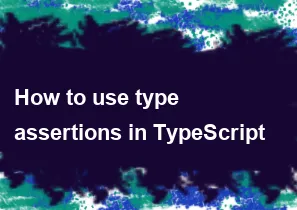How to use type assertions in TypeScript

In TypeScript, type assertions are a way to tell the compiler that you know more about the type of a value than what TypeScript can infer. It's important to note that type assertions do not perform any runtime checks or conversions; they are purely a way to provide hints to the TypeScript compiler.
There are two syntaxes for type assertions in TypeScript:
- Angle-bracket syntax:
typescriptlet someValue: any = "This is a string";
let strLength: number = (<string>someValue).length;
- As keyword syntax:
typescriptlet someValue: any = "This is a string";
let strLength: number = (someValue as string).length;
Both of these examples show how to assert that someValue is of type string. After the assertion, you can access the length property without TypeScript complaining.
However, it's important to use type assertions carefully, as they essentially tell the TypeScript compiler to trust your judgment. If you assert a type that the value doesn't actually have, you might run into runtime errors.
In many cases, it's better to use type annotations or ensure that your code allows TypeScript to infer types accurately. If you find yourself using type assertions frequently, it might be worth reevaluating your type definitions or exploring other TypeScript features to improve type safety.
-
Popular Post
- How to optimize for Google's About This Result feature for local businesses
- How to implement multi-language support in an Express.js application
- How to handle and optimize for changes in mobile search behavior
- How to handle CORS in a Node.js application
- How to use Vue.js with a UI framework (e.g., Vuetify, Element UI)
- How to configure Laravel Telescope for monitoring and profiling API requests
- How to create a command-line tool using the Commander.js library in Node.js
- How to implement code splitting in a React.js application
- How to use the AWS SDK for Node.js to interact with various AWS services
- How to use the Node.js Stream API for efficient data processing
- How to implement a cookie parser middleware in Node.js
- How to implement WebSockets for real-time communication in React
-
Latest Post
- How to implement a dynamic form with dynamic field styling based on user input in Next.js
- How to create a custom hook for handling user interactions with the browser's device motion in Next.js
- How to create a custom hook for handling user interactions with the browser's battery status in Next.js
- How to implement a dynamic form with dynamic field visibility based on user input in Next.js
- How to implement a dynamic form with real-time collaboration features in Next.js
- How to create a custom hook for handling user interactions with the browser's media devices in Next.js
- How to use the useSWRInfinite hook for paginating data with a custom loading indicator in Next.js
- How to create a custom hook for handling user interactions with the browser's network status in Next.js
- How to create a custom hook for handling user interactions with the browser's location in Next.js
- How to implement a dynamic form with multi-language support in Next.js
- How to create a custom hook for handling user interactions with the browser's ambient light sensor in Next.js
- How to use the useHover hook for creating interactive image zoom effects in Next.js